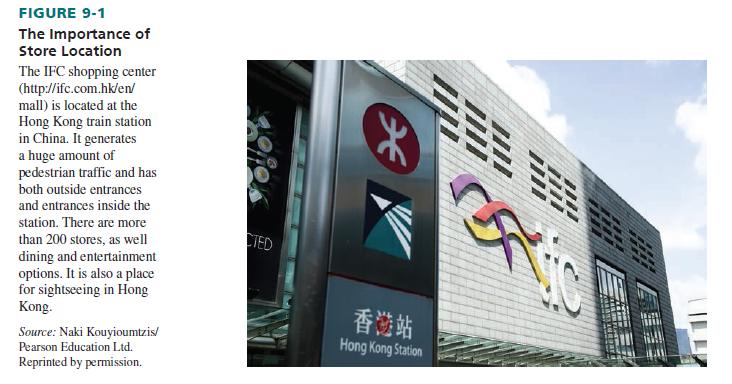Location decisions are complex. Costs can be quite high, there is little flexibility once a site is chosen, and locational attributes have a big impact on a strategy. One of the oldest retailing adages is that “location, location, location” is the major factor leading to a firm’s success or failure. See Figure 9-1.
A good location may be substantial enough to allow a retailer to succeed even if its strategy mix is mediocre. A hospital gift shop may do well, although its assortment is limited, its prices are high, and it does not advertise. On the other hand, a poor location may be such a liability that even superior retailers cannot overcome it. A mom-and-pop store may do poorly if it is across the street from a category-killer store; although the small firm features personal service, it cannot match the selection and prices. At a different site, however, it might prosper.
The choice of a location requires extensive decision making due to the number of criteria considered, including population size and traits, the competition, transportation access, parking availability, the nature of nearby stores, property costs, the length of the agreement, legal restrictions, and other factors.

A store location typically necessitates a sizable investment and a long-term commitment. Even a retailer that minimizes its investment by leasing (rather than owning a building and land) can incur large costs. Besides lease payments, the firm must spend money on lighting, fixtures, a storefront, and so on.
Although leases of less than 5 years are common in less desirable retailing locations, leases in good shopping centers or shopping districts are often 5 to 10 years or more. It is not uncommon for a supermarket lease to be 15 or 20 years. Department stores and large specialty stores on major downtown thoroughfares occasionally sign leases longer than 20 years.
Due to its fixed nature, the investment, and the length of the lease, store location is the least flexible element of a retail strategy. A firm cannot easily move to another site or convert to another format. Also, a retailer may be barred from subleasing to another party during the lease period; if a company breaks a lease, it may be responsible to the property owner for financial losses. In contrast, ads, prices, customer services, and assortment can be modified as the environment (consumers, competition, the economy) changes.
Even a retailer that owns its building and land may also find it hard to change locations. It has to find an acceptable buyer, which might take several months or longer, and it may have to assist the buyer with financing. It might also incur a loss, should it sell during an economic downturn.
A firm moving from to another locale faces three potential problems. (1) Some loyal shoppers and employees may be lost; the greater the distance between the old and new sites, the bigger the loss. (2) A new site may not have the same traits as the prior one. (3) Most store fixtures and renovations at a site cannot be transferred; their value is lost if they have not been fully depreciated.
Store location affects long- and short-run planning. In the long run, the choice of location influences the overall strategy. A retailer must be at a site that is consistent with its mission, goals, and target market for an extended time. It also must regularly study and monitor the status of the location as to population trends, the distances people travel to the store, and competitors’ entry and exit—and adapt accordingly.
In the short run, a location has an impact on specific elements of a strategy mix. A retailer in a downtown area with many office buildings may have little pedestrian traffic on weekends. It may be futile to try to sell items such as major appliances there. (Such items are often bought jointly by adult household members.) The retailer could either close on weekends and not stock certain products or remain open and try to attract customers to the area by aggressive promotion or pricing. If the retailer closes on weekends, it adapts its strategy mix to the attributes of the location. If it stays open, it invests additional resources in an attempt to alter shopping habits. A retailer that strives to overcome its location, by and large, faces greater risks than one that adapts.
Retailers should follow these four steps in choosing a store location:
- Evaluate alternate geographic (trading) areas in terms of the characteristics of residents and existing retailers.
- Determine whether to locate as an isolated store in an unplanned business district or in a planned shopping center within the geographic area.
- Select the general isolated store, unplanned business district, or planned shopping center location.
- Analyze alternate sites contained in the specified retail location type.
The selection of a store location is a process involving each of these steps. This chapter focuses on Step 1; Chapter 10 examines Steps 2, 3, and 4.
Source: Barry Berman, Joel R Evans, Patrali Chatterjee (2017), Retail Management: A Strategic Approach, Pearson; 13th edition.

F*ckin’ awesome things here. I am very happy to see your article. Thank you so much and i am taking a look ahead to touch you. Will you kindly drop me a e-mail?